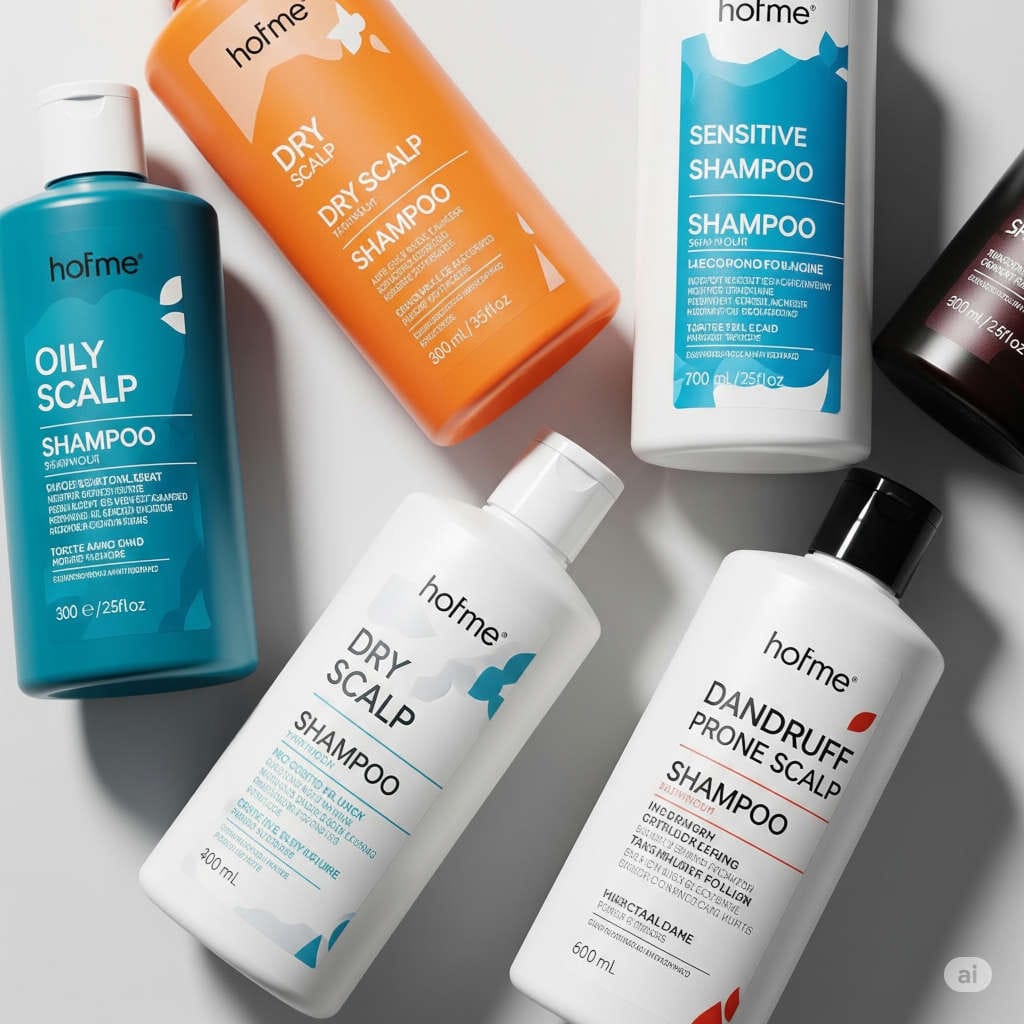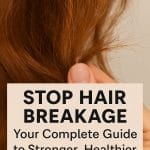When it comes to hair care, many of us focus on the length, color, or texture of our hair. But the true foundation of healthy hair is a healthy scalp. Choosing the right shampoo isn’t just about how it makes your hair look or smell—it’s about how it cares for the skin underneath.
Most people pick shampoos based on hair type (dry, frizzy, colored, etc.), but this approach often overlooks the scalp. And since shampoo is primarily designed to cleanse the scalp, not just the hair strands, it makes sense to start with scalp type when selecting your shampoo. In this comprehensive guide, we’ll walk you through everything you need to know to choose the perfect shampoo for your unique scalp needs.
Why Your Scalp Type Matters More Than You Think
Your scalp has oil glands, hair follicles, and sensitive skin—just like the rest of your body. But unlike the skin on your arms or legs, your scalp is often covered in hair, which can trap oil, sweat, and dirt. If your scalp is too dry, you may experience flaking, itching, or brittleness. If it’s too oily, your hair might feel greasy and heavy just a day after washing.
By understanding your scalp type, you can choose a shampoo that balances oil production, hydrates effectively, and soothes irritation. That leads to healthier hair from root to tip.
How to Identify Your Scalp Type
Before choosing a shampoo, figure out your scalp type. Here’s a simple method:
Step 1: Wash Your Hair
Shampoo your hair thoroughly and don’t apply any conditioner, serum, or styling products afterward.
Step 2: Wait 24 Hours
Let your hair and scalp return to their natural state. Don’t touch or manipulate it too much during this period.
Step 3: Observe and Feel
Look at your roots and feel your scalp:
- Oily Scalp: Your roots feel greasy or sticky.
- Dry Scalp: Feels tight, itchy, or has visible flakes.
- Combination Scalp: Oily at the roots, dry at the ends.
- Sensitive Scalp: Feels irritated, red, or reacts easily to products.
Types of Scalp and the Right Shampoo for Each
1. Oily Scalp
If your scalp gets greasy quickly, you’re likely dealing with an overproduction of sebum (natural oil). While some oil is healthy, too much can lead to clogged pores, limp hair, and even scalp acne.
Common Signs:
- Greasy roots within 24 hours of washing
- Flat, lifeless hair
- Frequent dandruff (which could be seborrheic dermatitis)
What You Need in a Shampoo:
- Ingredients that balance oil production
- Gentle but effective cleansers that won’t strip your scalp
- Lightweight formulas
Best Ingredients for Oily Scalps:
- Tea Tree Oil: Natural antimicrobial and helps regulate oil
- Salicylic Acid: Breaks down sebum and exfoliates scalp buildup
- Charcoal or Clay: Absorbs excess oil and purifies the scalp
- Apple Cider Vinegar: Balances pH and clarifies without over-drying
What to Avoid:
- Heavy moisturizing shampoos with oils or butters
- Cream-based formulas
- Over-washing, which can trigger more oil production
Top Picks:
- Paul Mitchell Tea Tree Special Shampoo
- Neutrogena Anti-Residue Clarifying Shampoo
- L’Oréal Paris Elvive Extraordinary Clay Shampoo
2. Dry Scalp
A dry scalp lacks moisture, often due to harsh shampoos, cold weather, or underlying skin conditions. It can lead to itchiness, flaking, and discomfort.
Common Signs:
- Tight, itchy scalp
- White flakes (not oily like dandruff)
- Hair feels brittle or dry
What You Need in a Shampoo:
- Hydrating and soothing ingredients
- Mild cleansers that don’t strip natural oils
- Moisture retention support
Best Ingredients for Dry Scalps:
- Aloe Vera: Soothes inflammation and provides moisture
- Coconut or Argan Oil: Deeply hydrating
- Glycerin: Draws moisture into the scalp
- Hyaluronic Acid: Locks in hydration
- Jojoba Oil: Closely resembles natural sebum
What to Avoid:
- Sulfates (like SLS and SLES)
- Alcohol-heavy formulations
- Synthetic fragrances
Top Picks:
- SheaMoisture Raw Shea Butter Moisture Retention Shampoo
- Briogeo Be Gentle, Be Kind Aloe + Oat Milk Ultra Soothing Shampoo
- Kiehl’s Amino Acid Shampoo
3. Combination Scalp
This scalp type presents a unique challenge: your roots may get oily quickly while your ends remain dry and frizzy.
Common Signs:
- Greasy roots and dry ends
- Need to shampoo every other day or every two days
What You Need in a Shampoo:
- Balanced cleansing and hydrating formula
- A two-part strategy: cleansing roots and moisturizing ends
Best Ingredients:
- Panthenol (Vitamin B5): Moisturizes and strengthens without heaviness
- Green Tea Extract: Lightweight antioxidant protection
- Apple Cider Vinegar: Clarifies and balances pH
- Mild Surfactants: Like cocamidopropyl betaine
What to Avoid:
- Heavy oils and butters
- Strong clarifying agents on a daily basis
Top Picks:
- Ouai Detox Shampoo (weekly use)
- Aveda Scalp Benefits Balancing Shampoo
- ACURE Curiously Clarifying Shampoo
4. Sensitive Scalp
Sensitive scalps react easily to hair products, often becoming red, itchy, or inflamed.
Common Signs:
- Burning or tingling sensation after using certain shampoos
- Red patches
- Flaking without itchiness
What You Need in a Shampoo:
- Hypoallergenic and fragrance-free formulas
- Calming, non-irritating ingredients
Best Ingredients:
- Oat Extract: Soothes irritation
- Chamomile: Reduces inflammation
- Aloe Vera: Gentle hydration
- Zinc Pyrithione: Fights microbial imbalances if dandruff is present
What to Avoid:
- Sulfates, parabens, and silicones
- Artificial dyes and perfumes
Top Picks:
- Vanicream Free & Clear Shampoo
- Eucerin DermoCapillaire Calming Shampoo
- La Roche-Posay Kerium Extra Gentle Shampoo
Shampoo Ingredients to Know (Good and Bad)
Here are some commonly found shampoo ingredients and their roles:
| Ingredient | Purpose | Best For |
|---|---|---|
| Tea Tree Oil | Antibacterial, antifungal | Oily, sensitive scalps |
| Salicylic Acid | Exfoliates dead skin, unclogs follicles | Oily, flaky scalps |
| Coal Tar | Slows down skin cell growth | Psoriasis, chronic dandruff |
| Ketoconazole | Antifungal for dandruff and fungus | Oily, dandruff-prone scalps |
| Glycerin | Moisturizing humectant | Dry, sensitive scalps |
| Sulfates (SLS/SLES) | Creates lather, deep cleans | Use sparingly on oily scalp |
| Panthenol | Adds shine and moisture | All scalp types |
| Silicones (dimethicone) | Smooth hair, adds shine | May build up on oily scalps |
How Often Should You Shampoo?
There’s no one-size-fits-all answer. It depends on your scalp type, lifestyle, and hair care routine.
| Scalp Type | Suggested Frequency |
|---|---|
| Oily | Every 1–2 days |
| Dry | Every 3–4 days |
| Combination | Every 2–3 days |
| Sensitive | Every 3–5 days (or as needed) |
Tip: Use lukewarm water, not hot. Heat can strip away natural oils and irritate your scalp.
Should You Rotate Your Shampoo?
Yes, sometimes! Your hair and scalp can change due to:
- Seasonal changes (dry winters vs humid summers)
- Hormonal fluctuations
- Diet, stress, or medications
- Product buildup
You might need:
- A clarifying shampoo once a week
- A moisturizing shampoo during dry seasons
- A medicated shampoo during flare-ups (eczema or dandruff)
Natural vs. Synthetic: What Really Matters?
Natural doesn’t always mean better. Some natural ingredients can irritate sensitive scalps. Similarly, not all synthetic ingredients are harmful.
Focus on what works for your scalp, not marketing buzzwords. Look for clinically tested, dermatologist-recommended options.
When to See a Dermatologist
If you experience:
- Persistent itching or flaking
- Painful bumps or lesions
- Hair loss or thinning patches
- Redness that won’t go away
It may be time to consult a professional. You could be dealing with a condition like seborrheic dermatitis, psoriasis, or an allergy that needs treatment.
Final Checklist: Choosing the Right Shampoo for You
Here’s a quick summary to help you make your pick:
Step 1: Know Your Scalp Type
Oily, dry, combination, or sensitive?
Step 2: Read the Ingredients
Look for beneficial ingredients and avoid known irritants.
Step 3: Match Frequency With Need
Don’t overwash or underwash. Create a balanced schedule.
Step 4: Rotate When Necessary
Use different shampoos for different needs—detox, hydration, soothing.
Step 5: Listen to Your Scalp
It tells you when something is off. Adjust your routine as needed.
Final Thoughts
Shampoo is more than a cleansing product—it’s a crucial part of your scalp care. A well-chosen shampoo can soothe dryness, control oiliness, ease sensitivity, and give your hair a healthy foundation to grow from.
Understanding your scalp type is the first step toward better hair days. Take time to observe your scalp, read product labels carefully, and don’t fall for marketing hype. The best shampoo for you is the one that keeps your scalp balanced, happy, and healthy.
Have a favorite shampoo that worked wonders for your scalp type? Share it in the comments—your tip could help someone else find their perfect match.
You might also like,
- Top 18 Best Shampoos for Dry Hair 2025: Restore Moisture & Shine
- Top 10 Best Shampoos for Men with Dry Scalp in 2025 (Derm-Approved Guide)
- Best Shampoos for Damaged Hair in 2025 | Restore & Repair with Top Expert Picks






